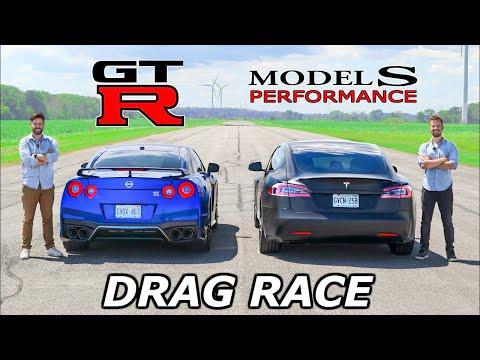When I first decided to take my Tesla Model S Performance and the Nissan GT-R for a head-to-head drag race, I was eager for a chance to experience the raw performance and technological prowess of these two iconic cars. I had owned the Tesla for a few years and had always admired its blend of speed, luxury, and cutting-edge technology. The Nissan GT-R, on the other hand, had been on my radar as a quintessential performance car, known for its aggressive stance and track-ready capabilities. It was a perfect setup for a thrilling comparison.
The day of the race arrived with a sense of anticipation. I had meticulously prepared both vehicles, making sure they were in top condition. For the Tesla Model S Performance, this meant checking the battery level, ensuring that the software was updated to the latest version, and verifying that all systems were functioning optimally. The GT-R required a different kind of preparation—one that involved checking tire pressures, reviewing the fluid levels, and making sure the turbochargers were in peak condition. Each car represented a different philosophy of performance, and I was excited to see how they would stack up against each other.
As the sun began to set, casting a golden glow over the track, I felt a rush of adrenaline. I positioned the Tesla Model S Performance at the starting line, the quiet hum of its electric motors barely perceptible. The GT-R, with its roaring V6 engine and aggressive stance, was positioned alongside it. The contrast was stark: one was sleek and futuristic, the other was raw and muscular. I could almost hear the cars talking to each other, each one eager to prove its superiority.
The drag race was set to be a pure test of acceleration. As the countdown began, I could feel the intensity build. The Tesla’s instant torque delivery promised an exhilarating launch, while the GT-R’s reputation for blistering acceleration was equally enticing. When the light turned green, I launched the Tesla with its characteristic electric surge. The acceleration was breathtaking, and within milliseconds, I was hurtling down the track. The Tesla’s dual electric motors delivered power seamlessly, pushing me back into the seat with relentless force.
The GT-R, however, was not to be underestimated. As soon as the launch control engaged, the Nissan roared to life, its turbocharged engine unleashing a ferocious burst of speed. The initial acceleration of the GT-R was incredibly strong, and I could feel the sheer power as the car clawed its way forward. The GT-R’s all-wheel-drive system provided exceptional traction, ensuring that it stayed glued to the track despite the immense power being delivered to the wheels.
In the drag race, the Tesla Model S Performance initially had the edge with its instant torque. The immediate response of the electric motors allowed it to get a quick start, but the GT-R’s advantage came into play as the race progressed. The Nissan’s superior top-end power and its ability to sustain high speeds for longer periods began to close the gap. As we approached the finish line, the GT-R was making a strong push, showcasing its remarkable speed and engineering prowess.
After the drag race, it was time for the roll race. This would test how each car performed from a higher speed, more akin to real-world driving conditions. We set off from 60 mph, and the difference in power delivery strategies became evident. The Tesla Model S Performance, with its silent and smooth acceleration, continued to impress. It surged forward effortlessly, its electric motors providing a continuous and linear acceleration. There was no gear-shifting drama, no lag—just a steady, unyielding push.
On the other hand, the Nissan GT-R, with its traditional internal combustion engine, had a different approach. As I accelerated, the engine’s roar filled the cabin, and I could feel the surge of power with every gear change. The GT-R’s transmission, while not as smooth as the Tesla’s single-speed setup, was incredibly responsive. Each shift was accompanied by a satisfying jolt, and the engine’s growl was a reminder of the raw performance that the GT-R was capable of.
In the roll race, the Tesla continued to showcase its incredible acceleration capabilities. The seamless power delivery meant that it was consistently fast, even as speeds increased. The GT-R, while impressive, had to work harder to keep up. Its performance was more dependent on engine revs and gear changes, but the driving experience was exhilarating in its own right.
Reflecting on the two races, it became clear that each car had its strengths and unique characteristics. The Tesla Model S Performance excelled in terms of instantaneous acceleration and smooth, linear power delivery. Its technological edge was apparent, and its performance was consistent and impressive. The Nissan GT-R, with its traditional engine and aggressive performance, offered a thrilling driving experience. The roar of the engine and the sensation of shifting gears provided a different kind of excitement, one that celebrated the art of high-performance engineering.
In the end, the choice between the Tesla Model S Performance and the Nissan GT-R comes down to personal preference. The Tesla represents the future of high-performance cars with its electric powertrain and advanced technology, while the GT-R embodies the raw, unfiltered joy of driving a performance car with a storied legacy. Both cars delivered exceptional experiences, and the race highlighted the remarkable qualities that make each vehicle special in its own right.
